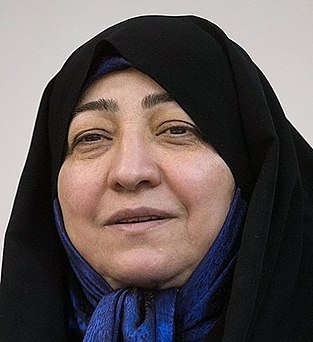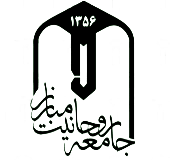
The Islamic Consultative Assembly, also called the Iranian Parliament, the Iranian Majles, is the national legislative body of Iran. The Parliament currently has 290 representatives, changed from the previous 272 seats since the 18 February 2000 election. The most recent election took place on 26 February 2016 and the new parliament was opened on 28 May 2016.

Mohammed Sadeq Givi Khalkhali was a Shia cleric of the Islamic Republic of Iran who is said to have "brought to his job as Chief Justice of the revolutionary courts a relish for summary execution" that earned him a reputation as Iran's "hanging judge". A farmer's son from Iranian Azeri origins was born in Givi in appearance Khalkhali was "a small, rotund man with a pointed beard, kindly smile, and a high-pitched giggle."

The Iranian parliamentary elections of February 20 and May 7, 2004 were a victory for Islamic conservatives over the reformist parties. Assisting the conservative victory was the disqualification of about 2500 reformist candidates earlier in January.

Legislative elections for Majlis of Iran were held on 14 March 2008, with a second round held on 25 April 2008. Conservatives loyal to President Mahmoud Ahmadinejad were considered the victors of the election, at least in part because "all the most prominent" reformist candidates were disqualified from running.

Parliamentary elections were held in Iran on 8 March 1996, with a second round on 19 April. The Combatant Clergy Association and its allies emerged as the largest bloc in the Majlis, winning 110 of the 270 seats.

The Democracy Party of Iran is an Iranian reformist political party that split from the Islamic Iran Solidarity Party in 2000.

Parliamentary elections were held in Iran on 13 March 1980, with a second round on 9 May. They were the first elections to the Majlis since the overthrow of the Shah, and were contested to a considerable degree on a party basis.

Parliamentary elections were held in Iran on 8 April 1988, with a second round on 13 May. The result was a victory for leftist politicians who later emerged as reformists. The number of clerics elected to the Majlis was reduced by over a third.

Parliamentary elections were held in Iran in 1952 to elect the 17th Iranian Majlis.
Parliamentary elections were held for the second time in Persia in 1909. The new Parliament convened on 19 November. The majority of the parliament was held by a some 53-seats coalition pioneered by Moderate Socialists Party.
This is a summary of the electoral history of Hassan Rouhani, an Iranian politician who is currently President of Iran since 2013 and member of the Assembly of Experts from Tehran Province since 2000. He was previously member of the Islamic Consultative Assembly (1980-2000).
This is a summary of the electoral history of Gholam-Ali Haddad-Adel, an Iranian Principlist politician who has been a member of Parliament of Iran since 2000 and was Speakers of the Parliament of Iran from 2004 to 2008.

Tehran, Rey, Shemiranat and Eslamshahr is a constituency for the Islamic Consultative Assembly.

Elaheh Rastgou is an Iranian conservative-minded reformist politician who is currently an outgoing member of City Council of Tehran. She was formerly a Member of Parliament.

Soheila Jolodarzadeh is an Iranian reformist politician and a member of the Parliament of Iran representing Tehran, Rey, Shemiranat and Eslamshahr electoral district. Jolodarzadeh is the first woman to be elected as a ″Secretary of the Board of Parliament of Iran″ in the history of Islamic Republic.
The elections for the sixth Majlis ended on 27 June 1926.
This is an overview of the Iranian legislative election, 2004 in Tehran, Rey, Shemiranat and Eslamshahr electoral district. Alliance of Builders of Islamic Iran was able to win 29 out of 30 seats in the constituency in the first round.
This is an overview of the Iranian legislative election, 2000 in Tehran, Rey, Shemiranat and Eslamshahr electoral district.

















